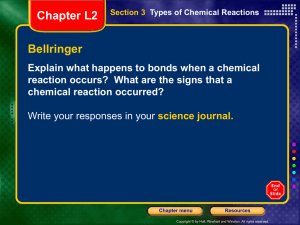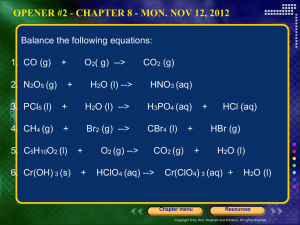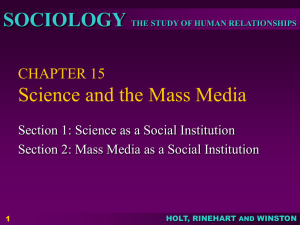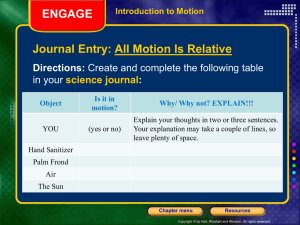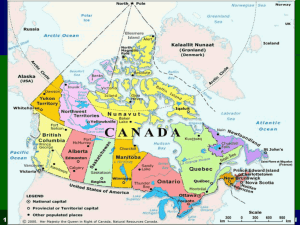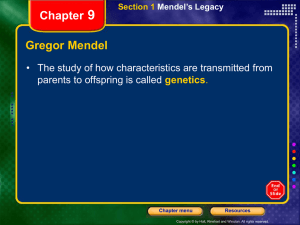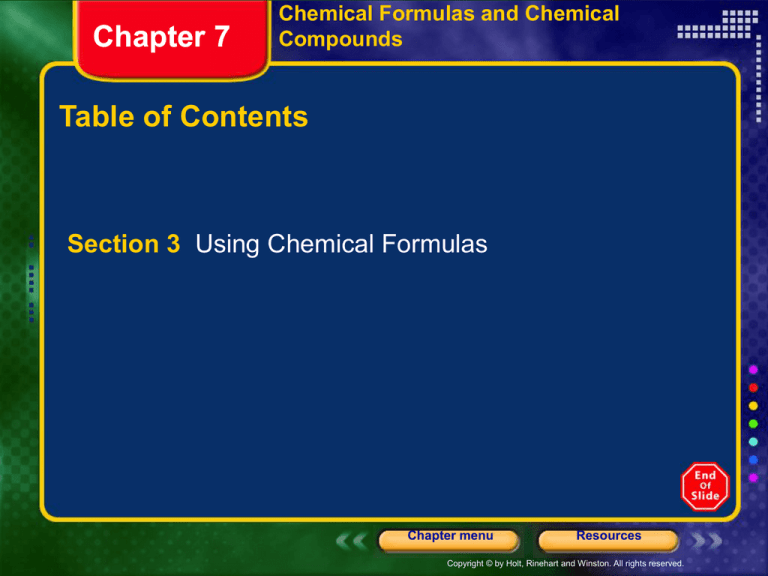
Chapter 7
Chemical Formulas and Chemical
Compounds
Table of Contents
Section 3 Using Chemical Formulas
Chapter menu
Resources
Copyright © by Holt, Rinehart and Winston. All rights reserved.
Chapter 7
Section 3 Using Chemical Formulas
Objectives
• Calculate the formula mass or molar mass of any given
compound.
• Use molar mass to convert between mass in grams and
amount in moles of a chemical compound.
• Calculate the number of molecules, formula units, or
ions in a given molar amount of a chemical compound.
• Calculate the percentage composition of a given
chemical compound.
Chapter menu
Resources
Copyright © by Holt, Rinehart and Winston. All rights reserved.
Chapter 7
Section 3 Using Chemical Formulas
• A chemical formula indicates:
• the elements present in a compound
• the relative number of atoms or ions of each
element present in a compound
• Chemical formulas also allow chemists to calculate a
number of other characteristic values for a
compound:
• formula mass
• molar mass
• percentage composition
Chapter menu
Resources
Copyright © by Holt, Rinehart and Winston. All rights reserved.
Chapter 7
Section 3 Using Chemical Formulas
Formula Masses
• The formula mass of any molecule, formula unit, or
ion is the sum of the average atomic masses of all
atoms represented in its formula.
• example: formula mass of water, H2O
average atomic mass of H: 1.01 amu
average atomic mass of O: 16.00 amu
average mass of H2O molecule: 18.02 amu
Chapter menu
Resources
Copyright © by Holt, Rinehart and Winston. All rights reserved.
Chapter 7
Section 3 Using Chemical Formulas
Formula Masses
• The mass of a water molecule can be referred to as a
molecular mass.
• The mass of one formula unit of an ionic compound,
such as NaCl, is not a molecular mass.
• The mass of any unit represented by a chemical
formula (H2O, NaCl) can be referred to as the formula
mass.
Chapter menu
Resources
Copyright © by Holt, Rinehart and Winston. All rights reserved.
Chapter 7
Visual Concepts
Formula Mass
Click below to watch the Visual Concept.
http://my.hrw.com/sh/hc6_003036809x/student/ch0
Visual Concept
7/sec03/vc00/hc607_03_v00fs.htm
Chapter menu
Resources
Copyright © by Holt, Rinehart and Winston. All rights reserved.
Chapter 7
Section 3 Using Chemical Formulas
Formula Masses, continued
Sample Problem F
Find the formula mass of potassium chlorate, KClO3.
Chapter menu
Resources
Copyright © by Holt, Rinehart and Winston. All rights reserved.
Chapter 7
Section 3 Using Chemical Formulas
Formula Masses, continued
Sample Problem F Solution
The mass of a formula unit of KClO3 is found by
adding the masses of one K atom, one Cl atom, and
three O atoms.
Atomic masses can be found in the periodic table in
the back of your book.
In your calculations, round each atomic mass to two
decimal places.
Chapter menu
Resources
Copyright © by Holt, Rinehart and Winston. All rights reserved.
Chapter 7
Section 3 Using Chemical Formulas
Formula Masses, continued
Sample Problem F Solution, continued
formula mass of KClO3 = 122.55 amu
Chapter menu
Resources
Copyright © by Holt, Rinehart and Winston. All rights reserved.
Chapter 7
Visual Concepts
Formula Mass Problem Calculation
Click below to watch the PROBLEM ACTIVITY.
PROBLEM ACTIVITY
Chapter menu
Resources
Copyright © by Holt, Rinehart and Winston. All rights reserved.
Chapter 7
Practice Problems pg. 238
• Complete the following problems.
Chapter menu
Resources
Copyright © by Holt, Rinehart and Winston. All rights reserved.
Chapter 7
Visual Concepts
The Mole
Click below to watch the Visual Concept.
http://my.hrw.com/sh/hc6_003036809x/stude
Visual Concept
nt/ch07/sec03/vc01/hc607_03_v01fs.htm
Chapter menu
Resources
Copyright © by Holt, Rinehart and Winston. All rights reserved.
Chapter 7
Section 3 Using Chemical Formulas
Molar Masses
• The molar mass of a substance is equal to the mass
in grams of one mole, or approximately 6.022 1023
particles, of the substance.
• example: the molar mass of pure calcium, Ca, is 40.08 g/mol
because one mole of calcium atoms has a mass of 40.08 g.
• The molar mass of a compound is calculated by
adding the masses of the elements present in a mole
of the molecules or formula units that make up the
compound.
Chapter menu
Resources
Copyright © by Holt, Rinehart and Winston. All rights reserved.
Chapter 7
Section 3 Using Chemical Formulas
Molar Masses, continued
• One mole of water molecules contains exactly two
moles of H atoms and one mole of O atoms. The
molar mass of water is calculated as follows.
molar mass of H2O molecule: 18.02 g/mol
• A compound’s molar mass is numerically equal to its
formula mass.
Chapter menu
Resources
Copyright © by Holt, Rinehart and Winston. All rights reserved.
Chapter 7
Visual Concepts
Molar Mass
Click below to watch the Visual Concept.
http://my.hrw.com/sh/hc6_003036809x/student/ch
Visual Concept
07/sec03/vc02/hc607_03_v02fs.htm
Chapter menu
Resources
Copyright © by Holt, Rinehart and Winston. All rights reserved.
Chapter 7
Section 3 Using Chemical Formulas
Calculating Molar Masses for Ionic Compounds
Chapter menu
Resources
Copyright © by Holt, Rinehart and Winston. All rights reserved.
Chapter 7
Section 3 Using Chemical Formulas
Molar Masses, continued
Sample Problem G
What is the molar mass of barium nitrate, Ba(NO3)2?
Chapter menu
Resources
Copyright © by Holt, Rinehart and Winston. All rights reserved.
Chapter 7
Section 3 Using Chemical Formulas
Molar Masses, continued
Sample Problem G Solution
One mole of barium nitrate, contains one mole of Ba, two moles of
N (1 2), and six moles of O (3 2).
molar mass of Ba(NO3)2 = 261.35 g/mol
Chapter menu
Resources
Copyright © by Holt, Rinehart and Winston. All rights reserved.
Chapter 7
Visual Concepts
Molar Mass Calculation
Click below to watch the Problem Activity.
PROBLEM ACTIVITY
Chapter menu
Resources
Copyright © by Holt, Rinehart and Winston. All rights reserved.
Chapter 7
Practice Problems pg. 239
Chapter menu
Resources
Copyright © by Holt, Rinehart and Winston. All rights reserved.
Chapter 7
Section 3 Using Chemical Formulas
Molar Mass as a Conversion Factor
• The molar mass of a compound can be used as a
conversion factor to relate an amount in moles to a
mass in grams for a given substance.
• To convert moles to grams, multiply the amount in
moles by the molar mass:
Amount in moles molar mass (g/mol)
= mass in grams
Chapter menu
Resources
Copyright © by Holt, Rinehart and Winston. All rights reserved.
Chapter 7
Section 3 Using Chemical Formulas
Mole-Mass Calculations
Chapter menu
Resources
Copyright © by Holt, Rinehart and Winston. All rights reserved.
Chapter 7
Visual Concepts
Molar Mass as a Conversion Factor
Click below to watch the Visual Concept.
http://my.hrw.com/sh/hc6_003036809x/s
Visual Concept
tudent/ch07/sec03/vc03/hc607_03_v03fs
.htm
Chapter menu
Resources
Copyright © by Holt, Rinehart and Winston. All rights reserved.
Chapter 7
Section 3 Using Chemical Formulas
Molar Mass as a Conversion Factor, continued
Sample Problem H
What is the mass in grams of 2.50 mol of oxygen gas?
Chapter menu
Resources
Copyright © by Holt, Rinehart and Winston. All rights reserved.
Chapter 7
Section 3 Using Chemical Formulas
Molar Mass as a Conversion Factor, continued
Sample Problem H Solution
Given: 2.50 mol O2
Unknown: mass of O2 in grams
Solution:
moles O2
grams O2
amount of O2 (mol) molar mass of O2 (g/mol) =
mass of O2 (g)
Chapter menu
Resources
Copyright © by Holt, Rinehart and Winston. All rights reserved.
Chapter 7
Section 3 Using Chemical Formulas
Molar Mass as a Conversion Factor, continued
Sample Problem H Solution, continued
Calculate the molar mass of O2.
Use the molar mass of O2 to convert moles to mass.
Chapter menu
Resources
Copyright © by Holt, Rinehart and Winston. All rights reserved.
Chapter 7
Section 3 Using Chemical Formulas
Converting Between Amount in Moles and
Number of Particles
Chapter menu
Resources
Copyright © by Holt, Rinehart and Winston. All rights reserved.
Chapter 7
Section 3 Using Chemical Formulas
Molar Mass as a Conversion Factor, continued
Sample Problem I
Ibuprofen, C13H18O2, is the active ingredient in many
nonprescription pain relievers. Its molar mass is
206.31 g/mol.
a. If the tablets in a bottle contain a total of 33 g of
ibuprofen, how many moles of ibuprofen are in the
bottle?
b. How many molecules of ibuprofen are in the bottle?
c. What is the total mass in grams of carbon in 33 g
of ibuprofen?
Chapter menu
Resources
Copyright © by Holt, Rinehart and Winston. All rights reserved.
Chapter 7
Section 3 Using Chemical Formulas
Molar Mass as a Conversion Factor, continued
Sample Problem I Solution
Given: 33 g of C13H18O2
molar mass 206.31 g/mol
Unknown: a. moles C13H18O2
b. molecules C13H18O2
c. total mass of C
Solution:
a. grams
moles
Chapter menu
Resources
Copyright © by Holt, Rinehart and Winston. All rights reserved.
Chapter 7
Section 3 Using Chemical Formulas
Molar Mass as a Conversion Factor, continued
Sample Problem I Solution, continued
b. moles
c. moles C13H18O2
molecules
moles C
Chapter menu
grams C
Resources
Copyright © by Holt, Rinehart and Winston. All rights reserved.
Chapter 7
Section 3 Using Chemical Formulas
Molar Mass as a Conversion Factor, continued
Sample Problem I Solution, continued
a.
b.
c.
Chapter menu
Resources
Copyright © by Holt, Rinehart and Winston. All rights reserved.
Chapter 7
Practice Problems pg. 242
• Complete the practice problems in your notes before
going to the next slide. Show ALL work as always!
Chapter menu
Resources
Copyright © by Holt, Rinehart and Winston. All rights reserved.
Chapter 7
ANSWERS pg. 242
• Be sure you have shown all of your work before checking
answers.
Note values may be rounded
to significant figures, so your
answer may
be slightly different.
Chapter menu
Resources
Copyright © by Holt, Rinehart and Winston. All rights reserved.
Chapter 7
Visual Concepts
Molecular Mass Problem Calculation
Do this problem if you still need help.
Click below to watch the PROBLEM ACTIVITY.
PROBLEM ACTIVITY
Chapter menu
Resources
Copyright © by Holt, Rinehart and Winston. All rights reserved.
7.3
Percent Composition and
Chemical Formulas
It helps to know the percents of
the components in a shirt
because they affect how warm it
is, whether it will need to be
ironed, and how it should be
cleaned. You will learn how the
percents of the elements in a
compound are important in
chemistry.
Slide
of 40
35
© Copyright Pearson Prentice Hall
End Show
7.3
Percent Composition and
Chemical Formulas
>
The Percent Composition of a
Compound
The Percent Composition of a Compound
How do you calculate the percent by
mass of an element in a compound?
Slide
of 40
36
© Copyright Pearson Prentice Hall
End Show
Chapter 7
Section 3 Using Chemical Formulas
Percentage Composition
• It is often useful to know the percentage by mass
of a particular element in a chemical compound.
• To find the mass percentage of an element in a
compound, the following equation can be used.
• The mass percentage of an element in a compound
is the same regardless of the sample’s size.
Chapter menu
Resources
Copyright © by Holt, Rinehart and Winston. All rights reserved.
Chapter 7
Section 3 Using Chemical Formulas
Percentage Composition, continued
• The percentage of an element in a compound can be
calculated by determining how many grams of the
element are present in one mole of the compound.
• The percentage by mass of each element in a
compound is known as the percentage
composition of the compound.
Chapter menu
Resources
Copyright © by Holt, Rinehart and Winston. All rights reserved.
7.3
Percent Composition and
Chemical Formulas
>
The Percent Composition of a
Compound
The percent by mass of an element in a
compound is the number of grams of the
element divided by the mass in grams of
the compound, multiplied by 100%.
Slide
of 40
39
© Copyright Pearson Prentice Hall
End Show
Chapter 7
Section 3 Using Chemical Formulas
Percentage Composition of Iron Oxides
Chapter menu
Resources
Copyright © by Holt, Rinehart and Winston. All rights reserved.
Chapter 7
Visual Concepts
Percentage Composition
Click below to watch the Visual Concept.
http://my.hrw.com/sh/hc6_003036809x/student/ch
Visual Concept
07/sec03/vc04/hc607_03_v04fs.htm
Chapter menu
Resources
Copyright © by Holt, Rinehart and Winston. All rights reserved.
7.3
Percent Composition and
Chemical Formulas
>
The Percent Composition of a
Compound
Percent Composition from Mass Data
The relative amounts of the elements in a
compound are expressed as the percent
composition or the percent by mass of each
element in the compound.
Slide
of 40
42
© Copyright Pearson Prentice Hall
End Show
Chapter 7
BUBBLICIOUS SONG AND BUBBLEGUM
LAB
• PLAY THE BUBBLICIOUS SONG AND COMPLETE
THE BUBBLEGUM LAB FOR PERCENTAGE
COMPOSITION.
Chapter menu
Resources
Copyright © by Holt, Rinehart and Winston. All rights reserved.
Chapter 7
Visual Concepts
Percentage Composition PROBLEM
ACTIVITY
Click below to watch the PROBLEM ACTIVITY.
PROBLEM ACTIVITY
Chapter menu
Resources
Copyright © by Holt, Rinehart and Winston. All rights reserved.
Chapter 7
Section 3 Using Chemical Formulas
Percentage Composition Calculations
Chapter menu
Resources
Copyright © by Holt, Rinehart and Winston. All rights reserved.
Chapter 7
Section 3 Using Chemical Formulas
Percentage Composition, continued
Sample Problem J
Find the percentage composition of copper(I) sulfide,
Cu2S.
Chapter menu
Resources
Copyright © by Holt, Rinehart and Winston. All rights reserved.
Chapter 7
Section 3 Using Chemical Formulas
Percentage Composition, continued
Sample Problem J Solution
Given: formula, Cu2S
Unknown: percentage composition of Cu2S
Solution:
formula
molar mass
mass percentage
of each element
Chapter menu
Resources
Copyright © by Holt, Rinehart and Winston. All rights reserved.
Chapter 7
Section 3 Using Chemical Formulas
Percentage Composition, continued
Sample Problem J Solution, continued
Molar mass of Cu2S = 159.2 g
Chapter menu
Resources
Copyright © by Holt, Rinehart and Winston. All rights reserved.
Chapter 7
Section 3 Using Chemical Formulas
Percentage Composition, continued
Sample Problem J Solution, continued
Chapter menu
Resources
Copyright © by Holt, Rinehart and Winston. All rights reserved.
Chapter 7
Practice Problems pg. 244
• Complete practice problems pg. 244 #1-2 only in your
notes. Show all of your work before checking
answers on the next slide. You must show work to
get any credit also. Rounding might cause answers
to be slightly off.
Chapter menu
Resources
Copyright © by Holt, Rinehart and Winston. All rights reserved.
Chapter 7
ANSWERS pg. 244
Chapter menu
Resources
Copyright © by Holt, Rinehart and Winston. All rights reserved.
Online Self-Check Quiz
Complete the online Quiz and record answers.
Ask if you have any questions about your
answers.
click here for online Quiz 7.3
(7 questions)
You must be in the “Play mode” for the
slideshow for hyperlink to work.
Slide
of 25
© Copyright Pearson Prentice Hall
End Show
VIDEOS FOR ADDITIONAL INSTRUCTION
Additional Videos for Section 7.3: Using Chemical
Formulas
Molar Mass
Slide
of 28
© Copyright Pearson Prentice Hall
End Show
End of Chapter 7.3 Show
Chapter menu
Resources
Copyright © by Holt, Rinehart and Winston. All rights reserved.

